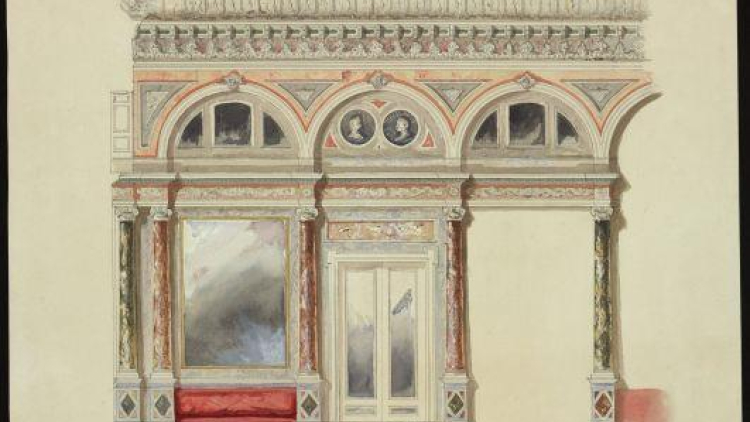Celebration of the Liceu's 175th anniversary
Publication date of the document: 01/04/2022
Year of the original document: 1847
It is now 175 years since Barcelona's Gran Teatre del Liceu first opened on Sunday, 4 April 1847. The new building's first stone had been laid two years earlier, in April 1845, on a site on La Rambla that had previously housed the Trinitarian convent. Miquel Garriga i Roca was the architect chosen to design it, although this task was taken over by Josep Oriol Mestres Esplugas soon afterwards, in 1846.
Fourteen years after its inauguration, also in April but in 1861, on the night of the 9th, the Liceu was engulfed by its first major fire, which completely destroyed the hall and the stage. It was fully rebuilt within a year. The document presented by the Historic Archive of the City of Barcelona (AHCB) in the document of the month is precisely one of the elevations of this reconstruction by the architect Josep Oriol Mestres. It became part of the AHCB's collection through his son, the artist Apel·les Mestres.
The Historical Archive of the City of Barcelona contains many documents relating to the history of music in Barcelona, and particularly about the Gran Teatre del Liceu. The records of the municipal documentation of the old government of the Consell de Cent allow you, for example, to learn about the work of trumpet and French horn players, other musicians and jongleurs affiliated to the Brotherhood of St. Bernard in the mid-15th century. Thanks to the Archive's institutional collections, such as the luthier Bartomeu Joan's 1495 inventory, we know about the tools used to make modern violas. Other institutional collections, such as that of the Cúria del Veguer and the Cúria del Corregidor, as well as private collections such as that of the Brotherhood of the Holy Spirit, also contain documents of interest from the 16th to 18th centuries.
The significance of Apel·les Mestres' personal collection from the 19th century is also worth mentioning. It is thanks to this collection that some of his father's documents on the construction of the building have been preserved. These include drawings of the structure, as well as countless elevations of the monumental ornamentation, particularly of the reconstruction following the fire of 1861. The Mestres family also preserved season tickets for almost half the 19th century in their private archive.
The architect Miquel Garriga i Roca's personal collection, which is also kept at the AHCB, includes a document of great importance: the request made by Fèlix Rivas, Josep Boxareu, Josep Oriol Mestres, Francesc Vilar and Miquel Garriga to widen Carrer de Sant Pau in anticipation of the Gran Teatre del Liceu being built. Another particularly noteworthy document belonging to Miquel Garriga i Roca himself, in this case in his capacity as municipal architect, is the famous set of cartographic sheets or "quarterons" containing a topographic survey of the old city's neighbourhoods exactly when the Eixample expansion was being planned. One of the sheets, more specifically number 93, depicts the urban area of La Rambla containing the Gran Teatre del Liceu originally designed by him fifteen years earlier. The Garriga and Roca sheets are the main focus of a multimedia resource at the Historic Archive of the City: Barcelona, one final look (https://darreramirada.ajuntament.barcelona.cat).
In addition to the Medieval and Modern Archive collections, other parts of the Historic Archive of the City contain documents on the history of the Gran Teatre del Liceu including both the 19th century and particularly the 20th century. The Graphics Section contains engravings showing opera and entertainment activities at the Liceu, such as masked balls, as well as promotional posters of its programmes. The collection of programmes, performances and invitations to balls, even during the Civil War and the post-war years, is worth highlighting. The collections of the AHCB's Library and its Newspaper Library, for their part, contain some iconic works, such as the painstakingly made deluxe edition published in 1848 to celebrate the Liceu’s first anniversary. It also contains collections of entities of great interest, such as the Sociedad del Liceo, with the agreement for the construction of the building and the entity's 1844 regulations. The Arlubins collection still contains, among others, libretti from operas performed at the Liceu.
Further information:
Celebration campaign for the Liceu's 175th anniversary:
Barcelona website, one final look:
Miquel Garriga i Roca collection at the Historic Archive of the City of Barcelona (AHCB):
Apeles Mestres collection at the Historic Archive of the City of Barcelona (AHCB):




